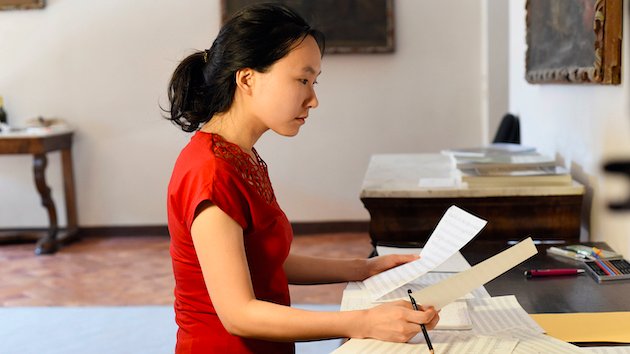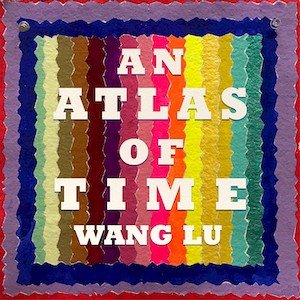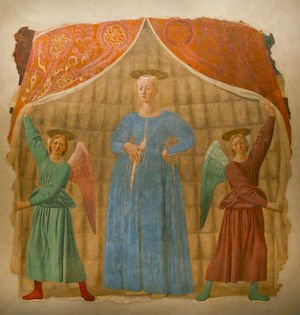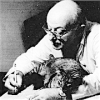
The works of Chinese-American composer Wang Lu unfold like pop-up books. Each brief movement releases a whirligig of hues and textures — far more activity than seems physically possible to pack in. Yet for all its charming eccentricity and sense of play, her music isn’t merely a cardboard magic-trick to entertain. Highly evocative sonic images conceal secret compartments with deep personal significance.
 An Atlas of Time (2013) is a suite of five character pieces that capture vivid memories from the composer’s life. All but the second open with a musical sample that acts as a Proustian trigger, setting off a web of responses from the 19-piece ensemble. Wang’s liner notes to this New Focus Recordings release offer a key to decoding her cryptic language of symbols.
An Atlas of Time (2013) is a suite of five character pieces that capture vivid memories from the composer’s life. All but the second open with a musical sample that acts as a Proustian trigger, setting off a web of responses from the 19-piece ensemble. Wang’s liner notes to this New Focus Recordings release offer a key to decoding her cryptic language of symbols.
In the first movement, “Internationale (1989),” fragments of the rousing Communist anthem alluded to in the title are constantly bombarded by flurries of percussion that stand in for the clang of construction outside the six-year-old Wang’s apartment in China. The parenthetical subtitle — the date of the Tiananmen Square massacre — adds a political subtext to this childhood reminiscence. Subversive punk-rock samples are pitted against the propaganda chorus in a staticky showdown, calling to mind the footage of demonstrators fearlessly defying government tanks.
Yet, this kind of interpretation of lived history is necessarily a retroactive one — it’s unlikely Wang, as a little girl, could have comprehended the events of 1989. The map implied by the cycle’s title is a composite one, with overlapping layers to show how the terrain has shifted as time passes. Wang’s collage of fractured tunes, sound effects, and “plunderphonic” recording snippets become potent representations of the layers of meaning that a memory accumulates as one matures.
The act of recollection is also reflected in her penchant for imitative counterpoint, distantly related to the compositional procedures of Renaissance polyphonists like Gesualdo (whose motet Peccantem me quotidie is quoted in the fourth movement). In the central “Piccolo Trumpets” movement, players stagger repetitions of the theme to a Chinese children’s radio program Wang listened to growing up. Each iteration of the three-note head-motif enters at a different pitch level with slight variations, as if Wang were trying to recall its contours.
As these successive statements compound in a chaotic stretto, they gradually morph into another sonic memory — this time the ubiquitous din of bicycles that were the main mode of urban transportation in the People’s Republic up until the 2000s. Under the direction of Gil Rose, members of the Boston Modern Orchestra Project nimbly coordinate an interlocking hocket of pointillistic squeaks, pings, honks, and clacks. Wang excels at such soundscapes — the apparent randomness is grounded in intricate rhythmic structures, paradoxically generating sonic verisimilitude through controlled artifice.
In capriccio passages like these, Wang displays a John Cagian love for pure noise and an inclination for musical mischief. Yet there’s another side to her style that is unexpectedly sparse, as demonstrated in the three chamber works that occupy the middle of this disc. In Ryan and Dan (2017), the titular duo — saxophonist Ryan Muncy and electric guitarist Daniel Lippel — give the impression of a strung-out grunge duo jamming in their garage. Lippel’s hypnotic drones flare up in rippling figures that resemble descending surf-rock runs or flourishes on the Chinese guqin zither. Muncy, emitting raspy multiphonics and pitchless air notes, duplicates his partner’s improvisatory gestures with percussive key-clicking.

The duet’s strange mixture of unease and lethargy also characterizes Wang’s string quartet Double Trance (2016), intended as a meditation on two moments of spiritual epiphany the composer experienced in Italy. Members of the Momenta Quartet antiphonally exchange phrases of a plainsong melody that runs threadlike through the piece, a tribute to nuns Wang heard singing at Rome’s Santa Cecilia basilica. There’s a certain anxiety undermining the chantlike solos and rustling, angel’s-wing harmonics in the accompaniment. Achieving an ambiguous blend of lyricism with tense harmonic foreboding, the ensemble perfectly captures the spirit of the work’s second inspiration, an enigmatic fresco by Piero della Francesca that depicts a downward-gazing Madonna between parted curtains.
Although the solo-violin work Unbreathable Colors (2017) is a response to the choking smog Wang encountered on a recent visit to her homeland, American listeners subjected to smoky wildfires and suffocating medical masks will somewhat identify with the shortness of breath she conjures. Soloist Miranda Cuckson replicates the composer’s pained breathing, alternating between dry, wheezy double-stops and pizzicato droplets that land like acid rain or toxic particles. The violinist allows silences to linger, lending the piece an eerie feeling of claustrophobic isolation, as if her performance were enveloped by thick, muffling haze.
For the closing track, we return to Wang’s scherzo idiom, bookending the album’s more desolate inner numbers with lighter fare. Siren Song (2008) is an absolute treat, performed with conviviality by Gil and the BMOP. Homer’s femme-fatale mermaids have become a fairly common presence in new music — Ana Sokolović and Unsuk Chin both picked up these mythical subjects in recent works. Unlike her colleagues, who logically turn to the voice to suggest the irresistible call of these sea nymphs, Wang eschews singers entirely. Granted, her title is most likely a reference to ambulance and police sirens, which the players imitate as part of an introductory traffic jam.
But even in the absence of a soprano to embody the electronic siren’s Homeric namesake, Wang uncannily evokes the human voice in all its subtleties through instrumental means. The rhythms and tones of the Mandarin dialect spoken in her hometown of Xi’an are converted into microtonal instrumental lines. Especially convincing are the players’ parroting of a high-pitched giggle. This laughter — along with ambient sounds, Chinese folk tunes, and Gershwinesque jazz riffs — is part of a kaleidoscopic palette of recurring motives with which Wang paints a street scene of frenetic energy. She dubs it a “short dramatic opera,” and you indeed get a sense of a berserk little puppet show being enacted, with plenty of cartoonish Mickey Mousing to mime the invisible action.
I’d be eager to hear what new timbres Wang could coax from an actual human voice. Of the few vocal works she’s produced, none have been commercially released on recording. I was thrilled, then, to learn that the Chicago Opera Theater has tapped Wang for its Vanguard Emerging Opera Composer Program. Her pictorial compositional language and knack for vocality (even if it’s an instrument doing the “singing”) will no doubt transfer successfully to the full-length opera commission her fellowship entitles.
Correction: The referenced piece Ryan & Dan was mistitled in the article as originally published.




